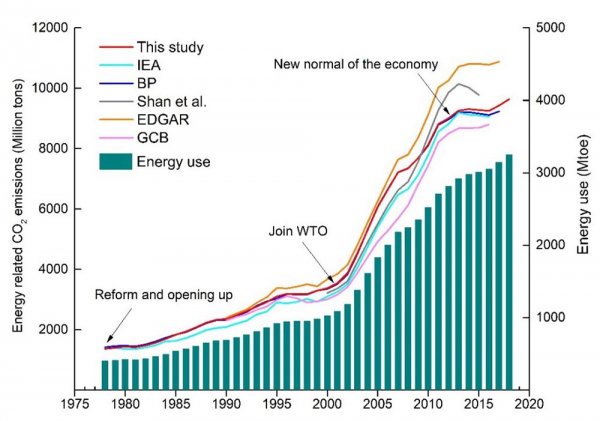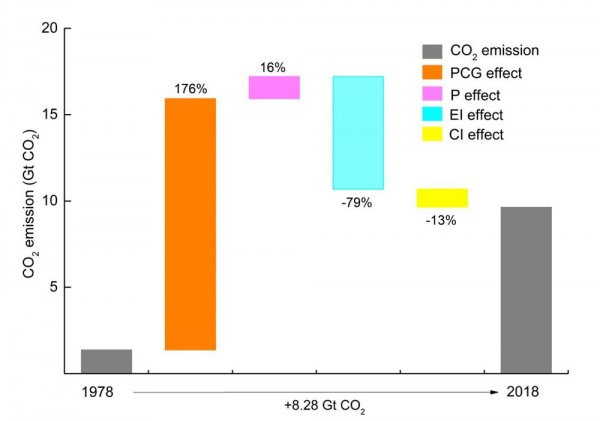The team of Lu Yonglong, a researcher at the Eco-Environmental Research Center of the Chinese Academy of Sciences, has made new progress in the research of sustainable development. His research titled "Drivers of change in China's energy-related CO2 emissions" (12) Published on the 23rd in the international journal "National Academy of Sciences" (PNAS) (doi.org/10.1073/pnas.1908513117). 2018, which has just passed, coincides with the 40th anniversary of China's reform and opening up. China's economic development has achieved world-renowned development achievements during these 40 years and has become the world's second largest economy. The rapid economic development has also brought many ecological and environmental problems, one of which is the rapid growth of carbon emissions from energy activities. The country with the largest global carbon emissions is China, which accounts for about 30% of global carbon emissions. In the context of the increasing shortage of global carbon emission space, countries are actively exploring how to effectively control the growth of carbon emissions through low-carbon transformation. Studying the influencing factors and changing characteristics of China's carbon emission growth since reform and opening up will help to improve the scientificity and operability of carbon emission control policies, and also provide useful inspiration and reference for other emerging economies. The article uses the material balance method to calculate the carbon emissions of China's energy activities in the 40 years of reform and opening up (1978-2018); using the Kaya formula and the logarithmic average Dirichlet factor decomposition method (LMDI) to the four main factors that affect the carbon emissions of energy activities The driving factors (GDP per capita, population, energy intensity, carbon intensity) have been factorized, combined with China ’s macroeconomic policies in each five-year plan, and analyzed the contribution rates of the four driving factors to changes in carbon emissions; The econometric Johansen cointegration test verified the LMDI decomposition results. The article believes that China's economic growth and energy activity carbon emission growth still maintain a strong coupling relationship, and energy activity carbon emissions have a long-term equilibrium relationship with population growth rate, per capita GDP, energy intensity and carbon intensity. The article finds that China's carbon emissions from energy activities increased by 8.275 billion tons from 1978 to 2018 (Figure 1). Among them, GDP per capita and population increased by approximately 14.56 billion and 1.29 billion tons, respectively, with a growth contribution rate of 176% and 16%; energy intensity and Carbon intensity suppressed emissions by -65.2 and -2.05 billion tons respectively, with growth contribution rates of -79% and -13%, respectively (Figure 2). The article also found that macroeconomic policies directly affect changes in carbon emissions by affecting changes in relevant indicators. Typically, China joined the World Trade Organization in 2001. The huge international market demand prompted the expansion of domestic high-energy-consuming industries, thus opening up carbon emissions. The volume is growing rapidly. The article finally pointed out that China's carbon emissions from energy activities will continue to maintain a low growth rate in the near future. The next 10-15 years will be a critical period for China to fulfill its commitment to peak carbon emissions. Controlling the growth rate of carbon emissions to achieve peak carbon emissions requires efforts to achieve Low-carbon transformation of economic growth, low-carbon transformation of energy system, low-carbon transformation of consumption mode. Corresponding authors of the article are the ecological center Lu Yonglong and Professor Oslo University Nils Chr. Stenseth. The first author is Lu Yonglong's PhD student Zheng Xiaoqi. The co-authors include Yuan Jingjing, Yvette Baninla, Zhang Sheng, Dag O. Hessen, Tian Hanqin, Michael Obersteiner, Chen Deliang et al. The participating organizations include: Ecology Center of Chinese Academy of Sciences, School of Environment, Renmin University of China, Xiamen University, University of Chinese Academy of Sciences, Oslo University, Tsinghua University, Auburn University, Austrian Institute of International Applied Systems and University of Gothenburg, Sweden. The research results have been supported by the National Key Research and Development Program (2017YFC0505704), the National Natural Science Foundation of China (41420104004 and 71776147001), the Chinese Academy of Sciences Key Deployment Project (KFZD-SW-322), etc.
PC rod is a high-quality bar made of polycarbonate as the main component and co-extrusion technology CO-EXTRUSION. Because the surface is covered with a high concentration of UV absorbers, in addition to UV-resistant properties,it can maintain long-term weather resistance and never fade.PC Rod connection can be connected with special glue to effectively prevent leakage.PC Rod has good mechanical properties,light weight,impact resistance and weather resistance,maintain stable physical properties in the range of -40 ° C to +120 ° C.
Product
Diameter(mm)
Length(mm)
Color
Density(g/cm³)
PC ROD
20-200
1000
clear
1.2
PC Rod polycarbonate rod, PC rod, pc bar, polycarbonate bars,solid polycarbonate rod Shenzhen Anheda Plastic Products Co.,Ltd , https://www.ahdplastic.com
Figure 1 Changes in carbon emissions from China's energy activities from 1978 to 2018 
Figure 2 The contribution rate of different influencing factors to carbon emissions from 1978 to 2018